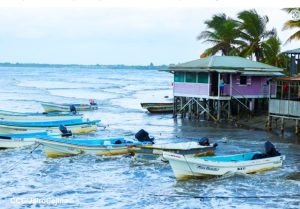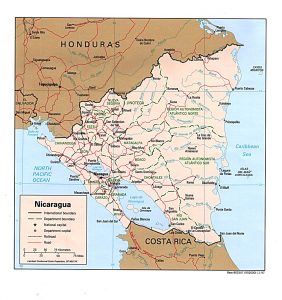Nicaragua’s government seeks to ensure productivity growth in the fisheries sector, all the while maintaining food security and sovereignty
This article is by Dennis Mairena Arauz (mairena@cadpi.org) of the Center for the Authonomy and Development of Indigenous Peoples, Nicaragua
The current state and trajectory of the artisanal fishing sector in Nicaragua’s autonomous regions along the Caribbean coast deserve a closer look and conversation. Such an examination can draw from several sources of official information of the Government of Reconciliation and National Unity of Nicaragua. Through the fishing sector institute Nicaraguan Institute of Fisheries and Aquaculture (INPESCA), the government presented the axes and lines of action for the year 2024. This is a part of the National Plan to Fight Poverty under the Strategy for Production, Promotion and Monitoring of Fisheries and Aquaculture 2022-2026.
These strategies and plans seek to ensure the growth of productivity, production, exports, food security and sovereignty, capacity development and technology transfer, and market diversification. These are with full and effective participation of all stakeholders.
The connection between Indigenous Peoples and their lands is multifaceted, aimed at maintaining livelihoods, preserving cultural heritage, and empowering communities to resist external pressures. Recognizing and respecting this connection is essential to promoting justice, equity and sustainable development.
Indigenous peoples see their traditional lands as more than just physical spaces. Their land holds immense spiritual and cultural significance. Their identity is closely tied to the land. The Miskitu people in Nicaragua’s northeast and east explain that the mermaid Liwa Mairin has a spiritual importance. That she cares for the waters and their beings, as well as other spirits that reside in the forests and in sacred sites.
Nicaragua has 27 indigenous territories duly demarcated and titled, with their own territorial governance structures protected by Law 28 on regional autonomy and Law 445 on communal lands
Through generations of intimate knowledge and stewardship, indigenous communities have developed a deep understanding of their waters and the intricate ecosystems of their land. They use their resources sustainably, supporting their communities and preserving their cultural heritage.
Their traditional knowledge includes practices such as rotational agriculture, sustainable hunting and respectful resource extraction. These ensure that waters and lands remain healthy and productive for future generations. In remote communities, hunting and fishing are carried out for the consumption of the family and community. Where the market is accessible, these resources are extracted in greater quantities.
The struggle, the recognition
Indigenous peoples have been actively fighting for the recognition of their collective rights to own, manage and develop their traditional waters, lands and resources. They advocate for their rights, both nationally and internationally. The UN Declaration on the Rights of Indigenous Peoples emphasizes their control over lands, territories and resources. This control allows them to maintain their institutions, cultures and traditions while promoting development aligned with their aspirations and needs.
Organizations such as the International Fund for Agricultural Development (IFAD) recognize that ensuring Indigenous Peoples’ access to resources is essential for long-term inclusive and sustainable development.
Nicaragua has 27 indigenous territories duly demarcated and titled, with their own territorial governance structures protected by Law 28 on regional autonomy and Law 445 on communal lands.
Indigenous lands often contain valuable resources such as timber, minerals and biodiversity. When indigenous communities have control over these resources, they can engage in economic activities that benefit their livelihoods. Examples include ecotourism, craft and sustainable forestry. Secure livelihoods are intertwined with cultural identity. When Indigenous Peoples are able to continue their traditional practices on their ancestral lands, this has a positive impact on their mental and emotional well-being.
Indigenous lands are repositories of cultural heritage. They contain sacred places, cemeteries and historical monuments. By maintaining their connection to these places, indigenous communities ensure the continuity of their cultural practices and stories. The land provides the context for transmitting oral traditions, languages and rituals. Elders share wisdom with younger generations, reinforcing cultural identity. Indigenous art, music and craft are often inspired by the natural environment. The earth serves as muse and canvas, allowing creativity to flourish.
Nicaragua lies between the Caribbean Sea and the Pacific Ocean. Its enormous water basins feed two large freshwater lakes that cover 8,264 sq km (Lake Cocibolca) and 1,049 sq km (Lake Xolotlan). The autonomous regions of the Caribbean are inhabited by the Miskitus, Mayangnas, Uluas, Garifunas, Creoles and Ramas and Mestizos peoples. There is a series of coastal lagoons of great richness in marine and coastal biodiversity, such as Bluefields Bay, Pearl Lagoon, Karata, Pahra, Dakura, Krukira, and Bismuna, to name just a few.

INPESCA’s strategy is based on the following guidelines:
In compliance with this strategy, Nicaragua proposes the following actions for 2024:
Institutional goals
For the sustainable use of marine and inland resources:

Current situation
According to an INPESCA report, Nicaragua experienced growth in the fishing and aquaculture sector from 2006 to 2023, reflecting progress in production, export and valuation of the sector. Since 2006, fishing and aquaculture production has grown 282 per cent, rising from 44 million pounds (about 19,960 tonnes) to 168 million pounds (about 76,200 tonnes) in 2023.
As for exports, these increased by 224 per cent, from 33 million pounds (about 14,968 tonnes) in 2006 to 107 million (about 48,535 tonnes) in 2023. Furthermore, the value of these exports increased by 141 per cent, from US $112 million to $270 million.
The National Strategy for the Promotion of Small-Scale Aquaculture, implemented since 2020, achieved the construction of approximately 1,000 ponds per year, training 19,000 practitioners and delivering 60,000 fingerlings.
The processing sector registers a 140 per cent increase in fishing and aquaculture plants, going up from 15 in 2006 to 36 in 2023, distributed between the Caribbean and the Pacific coasts. Employment in the sector has grown by 42 per cent, from 30,000 jobs in 2006 to 44,000 in 2023. The fishing sector contributes 1.1 per cent to the gross domestic product, generating approximately 27,746 jobs. These are distributed as follows:
The per capita consumption of fishery and aquaculture products has increased by 150 per cent, from 2.3 kg in 2006 to 6.7 kg in 2023, reflecting greater availability and preference for these products. In addition, 113,000 people have been trained in areas such as value addition, safety and good diving practices.
The vast majority fish in small canoes (wooden cayucos) and fiberglass pangas of under 12 metres in length, which puts them at high risk and vulnerability to the elements during rough sea conditions. Engine failures, collisions with other vessels, overloading and capsizing of pangas and canoes, problems associated with decompression and air supply in diving, entanglements in fishing nets, navigation errors, negligent practices, and crew falling overboard, are the main causes of accidents in Nicaragua’s artisanal fishing sector.
In the last decade, the safety of fishermen has been further reduced due to the impact of climate change. Storms and hurricanes appear more frequently and are more severe, as demonstrated by hurricanes Eta and Iota in November 2020.
Challenges
In Nicaragua, the main species caught in fishing and aquaculture are shrimp, tilapia, dolphin (mahi mahi), sailfish and barracuda. Most of the fishing production originates in the artisanal fishing sub-sector, which receives tax exemptions and benefits from the state.
Nicaragua’s entry into the European market was achieved after meeting EU requirements on cold chains by the private sector. Currently, Nicaraguan fishery and aquaculture products also have entry into the markets of the US, Canada and China. For shrimp farming, Nicaragua has granted a mangrove area concession for 17,000 ha, of which only 545 are in an intensive system, almost 15,000 are in a semi-intensive system and the rest are in the artisanal sector.
The fishing sector in Nicaragua faces several challenges. The following stand out:
For more
INPESCA informa los ejes estratégicos y líneas de acción 2024
https://www.canal4.com.ni/inpesca-informa-los-ejes-estrategicos-y-lineas-de-accion-2024/
Supporting the recognition of Indigenous Peoples tenure rights
https://www.fao.org/indigenous-peoples/our-work/tenure-rights/en/
INPESCA: Avances en la Pesca y Acuicultura de Nicaragua (2006-2023)
https://nuevaya.com.ni/inpesca-avances-en-la-pesca-y-acuicultura-de-nicaragua-2006-2023/
Nicaragua: A cuatro meses de los huracanes Eta e Iota, medio millón de personas sigue sin agua
https://news.un.org/es/story/2021/03/1489452
The Challenge of ‘Territory’: Weaving the Social Fabric of Indigenous Communities in Nicaragua’s Northern Caribbean Autonomous Region: The Challenge of ‘Territory’
https://www.researchgate.net/publication/303834471_The_Challenge_of_’Territory’_Weaving_the_Social_Fabric_of_Indigenous_Communities_in_Nicaragua’s_Northern_Caribbean_Autonomous_Region_The_Challenge_of_’Territory’